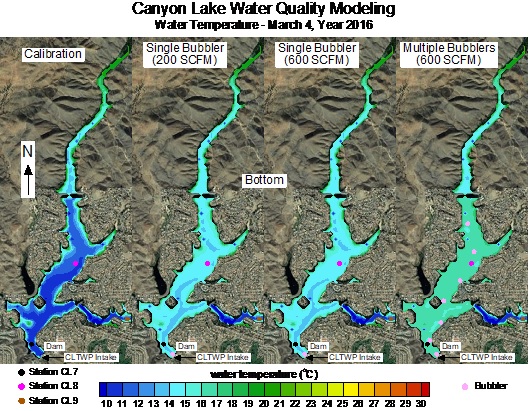
Canyon Lake Water Quality Modeling Study
Elsinore Valley Municipal Water District
Riverside, California
Flow Science has conducted a water quality analysis and modeling study of Canyon Lake, CA to identify potential water quality issues at the lake and outline possible solutions to these issues. To accurately evaluate the effectiveness of the proposed solutions, a three-dimensional water quality model has been developed for Canyon Lake. The Canyon Lake water quality model was first calibrated using observed field data. The calibrated model was then applied to study the performance and sizing of two proposed water quality improvement solutions for the main basin: destratification by aeration and hypolimnetic oxygenation.
For the destratification option, the model results indicated that the existing aeration system in the lake is not adequate to improve the DO levels at the bottom of the main basin. A multiple-aerator system that distributes the compressed air throughout the main basin is more effective for Canyon Lake due to the lake’s elongated shape. For the hypolimnetic oxygenation option, the model showed that a high oxygen injection rate would be needed to maintain adequate DO concentrations and reduce sediment nutrient release along most of the bottom of the main basin. However, with the calculated high oxygen injection rate, the proposed oxygenation system can induce vertical mixing in the water column and weaken the stratification in the lake. This implies a reduction in the efficiency of the oxygenation system and, more importantly, neglects the advantage of the oxygenation approach over the aeration approach, i.e., maintaining the stratification while increasing DO concentrations at the bottom of the lake.